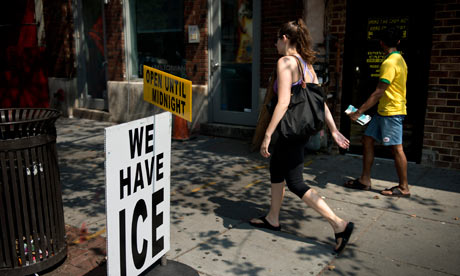With the US heatwave and Europe’s rain, records are tumbling. Formerly rare occurrences are becoming the new normal
John Vidal
guardian.co.uk, Wednesday 4 July 2012
Britain and northern Europe are dripping their way into what is already being called a “lost summer”. We have had our wettest April and June and our coldest spring, and there is no end in sight of the abnormal weather. But we can take some comfort in the fact that we are not alone.
In the US, 100 million people in 17 states have now had to be warned about the dangers of one of most intense heatwaves of the last century. Life in many US cities has become unbearable, with temperatures well over 100F (38C) lasting for many days now. More than 40,000 temperature records have already been set in the US this year and freak storms, record rainfall and giant forest fires have left millions suffering. Many old people will certainly die in the heatwave and food prices are bound to rise.
But this extreme weather is far more widespread than just northern Europe or the US. May was the second warmest ever recorded worldwide and the warmest on record for the northern hemisphere. The link between a warming atmosphere and individual climatic events is unclear but no one should doubt the physical turmoil. In the last few weeks we have seen the Arctic sea ice melting at a record pace, the Amazon reaching its highest level on record, massive forest fires in Siberia and the Russian east, temperatures climbing to a barely imaginable 48C in northern India, and an abnormally strong monsoon which has so far left many hundreds dead and nearly 7 million people homeless from floods in Assam and southern Bangladesh.
There’s always been freak weather, but climatologists increasingly think these events are becoming less unusual. Instead of taking place every 10 or 20 years, they are happening every two or three. This, they are beginning to say, is the new normal, a taste of the future as the planet warms.
Last year was the 35th consecutive year since 1976 that the yearly global temperature was above average. Since 2000 we have had 11 of the 13 warmest years in 132 years and the patterns of global warming that scientists warned about – such as more droughts, sudden downpours, more widespread wildfires, volatile heat, violent storms and more frequent heatwaves – are all here now. This, say the scientists with increasing conviction, is what the early stages of global warming looks like.
So how much more extreme weather does it take for governments and individuals to act, or for the oil companies to withdraw from the Arctic, or the media to link global warming with the events now being witnessed around the world? Must the sea boil, the Seine run dry, New York flood and the London Olympics be consumed by fire before countries are shocked into taking concerted action? The reality is that even as the world experiences increasing numbers of weather-related disasters and extreme events, climate change has dropped off the rich countries’ political and media agendas, and public concern is said to be waning – to the cheers of the sceptics and industry.
This is a most dangerous period. We still have a very good chance of avoiding the worst of climate change but the collective will to try to do anything appears to be weakening and confidence in politicians is at rock bottom. Unless the climate of opinion changes, the present economic storms may seem as nothing.
• Follow Comment is free on Twitter @commentisfree
See online: As the climate changes, extreme weather isn’t that extreme any more

